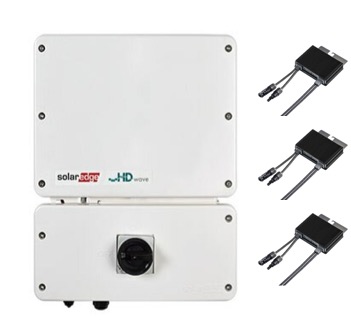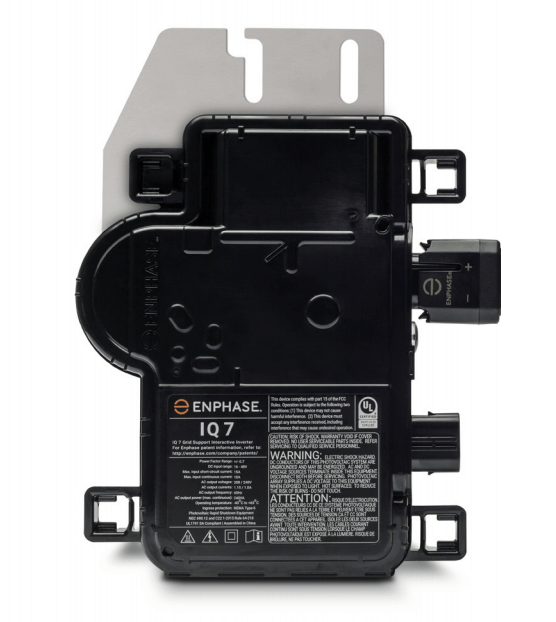Choosing the Right Solar Inverter
This guide will help you to choose the best solar inverter for your project. Use this handy reference table to compare the facts. Quickly see the difference in features, performance, warranty and more. Make an informed decision so you know what you are buying. However, these products are ever-changing, with new models or capabilities being added all the time. We'll do our best to keep you up to date with the industry.
| TYPE | STRING |
STRING + OPTIMIZER |
MICRO-INVERTER | HYBRID |
| DESCRIPTION | Most common and economical option, works great in direct sun. | Add device to back of each panel to "optimize" performance. Each panel operates independently. | Add device to back of each panel to "optimize" performance AND convert from DC to AC power. | String or micro-inverter that works gird-tied or off-grid; Connects solar + optional backup battery to the house. |
| GRID-TIED |
Yes | Yes | Yes | Yes |
| OFF-GRID |
No | No | No | Yes |
| BATTERY READY | No | No | No | Yes |
| RAPID ROOF SHUTDOWN |
Optional | Integrated | Integrated | Optional or Integrated |
| PERFORMANCE IN DIRECT SUN |
Up to 98% Efficiency | about 2% more | about 2% more | Varies |
| SHADE MANAGEMENT |
Each string | Each panel | Each panel | Varies |
| PANEL OUTAGE |
Affected string non-operational | Each panel operates independently | Each panel operates independently | Varies |
| MONITORING | Whole system or each string | Each panel | Each panel | Varies |
| WARRANTY STANDARD |
10 years | 12 years | 10 to 25 years | 5 to 25 years, varies by model |
| WARRANTY EXTENDED |
20 years | 25 years | N/A | 20 years |
| COST | Most economical | Add 6% to 10% to system cost | Add 6% to 10% to system cost | Add 10% to 25% to system cost |
| COMMON BRANDS |
SMA Fronius Delta |
Enphase Energy APSystems Chilicon |
Enphase IQ8 |
|
| WIRING CONCEPT |
Panel output cables are wired together to form a string, up to a dozen or so panels. Inverter has input for 2 to 4 strings. The inverter then combines the output and converts to AC power connected to the electrical box. |
Panel output cables are wired to a small optimizer device mounted to the back of each panel. The optimizer's are then connected together to form a string, usually 8 to 15 panels. Inverter has input for 2 to 4 strings. The inverter then combines the output and converts to AC power connected to the electrical box. |
Panel output cables are wired to a small micro-inverter mounted to the back of each panel. The micros are then connected together to form an AC circuit, with up to 11 to 16 panels. Each AC branch circuit can then be combined, or wired to it's own circuit breaker connected to the electrical box. | Varies by model. Similar to String or string + optimizer or micro-nverters wiring. |
 |
 |
 |
 |
What to know about solar inverters
There are FOUR basic types of solar inverter: String, String + Optimizer, Micro-inverter, and Hybrid.
A grid-tied, string inverter is the most economical approach. Works just fine in direct Sun when shade is not an issue. Multiple strings, or groups of panels, are wired together, and then connected to the inverter. Each string operates independently. The string inverter may need replacement in 15 to 20 years. Ideal for ground-mounted systems or buildings where rooftop shutdown is not required.
A string inverter with Optimizers has a small device added to the back of each panel to "optimize" performance. Each panel operates independently, it can be monitored, and includes rooftop shutdown capability. Optimizers help minimize shade losses and improve overall performance.
Micro-inverters also adds a device to back of each panel to "optimize" performance AND convert from DC to AC power. Each panel operates independently, it can be monitored and includes rooftop shutdown capability. Micro-inverters help minimize shade losses and improve overall performance. The smaller electronics have a longer lifespan, and a brand like Enphase has a 25 year warranty.
Finally, a Hybrid inverter can work both on-grid, or off-grid with optional batteries. The solar panels and storage batteries are connected in one unit. The hybrid inverter also has an internal power transfer switch to deliver power during an outage. Some customers buy a hybrid inverter to be battery-ready and future-proof the system in anticipation that battery prices will decrease over time. Can add rooftop shutdown or optimizers as needed. Some hybrid inverters even let you connect a fuel generator as another power source to charge your batteries and power your home or business.
The value of good design
Most of the solar kits include an up-front design in the price. We want to make sure you get the right kit, with the right parts, for your project. The design covers topics like the power consumption, system sizing, the electrical connection and the structural mounting. Once the design is complete and the order placed, we will prepare a custom permit plan blueprint for the project. You you can provide the plan to the local building authority and utility for net metering approval. This value-added service is unique to SunWatts. The solar design can be ordered separately to get the project started. Then you will get credit for the design fee with solar kits that are 5kW size or larger.
What is a hybrid solar inverter?
A Hybrid PV solar inverter can deliver power during either on-grid or off-grid conditions. The grid-connected systems have solar panels for utility savings, and a battery for backup power and peace of mind. Never be without power when you get energy from the Sun, the utility company or the batteries.
Both the PV array and the utility power can keep the batteries charged. In the event of a utility outage, the batteries deliver electricity to the household for normal, everyday use. If the utility is down for many days, don't worry, the solar panels will generate electricity for the home and charge the batteries.
Types of Hybrid Solar Inverters
As the solar industry has evolved, most modern solar inverters have hybrid capability. Some inverters are "MILD HYBRID" because they require additional components to work off-grid. The more popular are "ALL-IN-ONE" hybrid inverters that do not require additional components.
Mild-hybrid inverters are not intended for full off-grid capability, while all-in-one inverters generally can operate entirely off-grid, and with higher output capacity. Both types can also connect with a fuel generator for another layer of backup.
The additional components required by mild-hybrid inverters are commonly called a "controller" or "backup interface" or "gateway" or "backup start". In simple terms, this component provides the auto-transfer capability to create a local "micro-grid" for backup operation. This component requires additional costs and wiring. Popular brands of the mild-hybrid type include Enphase microinverters, SolarEdge Home Hub, Canadian EP Cube, SMA Smart Energy, Fronius Gen24, Tesla, Franklin, GoodWe, Growatt, or Solis.
The mild-hybrid inverters usually have a smaller AC output rating as they are intended for partial-home backup. However, they are modular, so multiple inverters can be added to achieve higher AC output needed for whole-home backup.
In the case of all-in-one hybrid inverters, the micro-grid capability and auto-transfer switch are integrated with the inverter. No additional wiring or hardware costs are necessary. In addition, these all-in-one hybrid inverters generally have higher AC output and surge capability, often with 200A pass-through rating, to power an entire house for whole-home backup. Popular brands of this type include Sol-Ark, EG4, Fortress or LuxPower.
Both types of hybrid inverters can work with DC connected solar panels, especially for new systems. They can also work with AC-coupled solar panels to integrate with existing, older solar arrays.
Battery Compatibility with Hybrid Inverters
The mild-hybrid inverters often work with specific batteries from either the inverter manufacturer or a third-party battery manufacturer. The batteries typically operate at higher DC voltage around 400 volts.
For example, the Enphase system only works with Enphase batteries. The SMA Smart Energy inverters only work with BYD batteries. The SolarEdge Home Hub inverters only work with SolarEdge batteries or the LG Chem RESU Prime batteries. High voltage batteries are generally more expensive, and have a 10 year warranty with a longer lifespan or "cycle" life.
In contrast, the All-In-One hybrid inverters are battery independent. They can work with most any low voltage battery that operates at 48 volts DC. Because there are many suppliers of low voltage 48V batteries, they generally are a better value. Most offer a 10 year warranty, with lifespan ranging from 6,000 to 10,000 cycles, or 16 years to 27 years.
